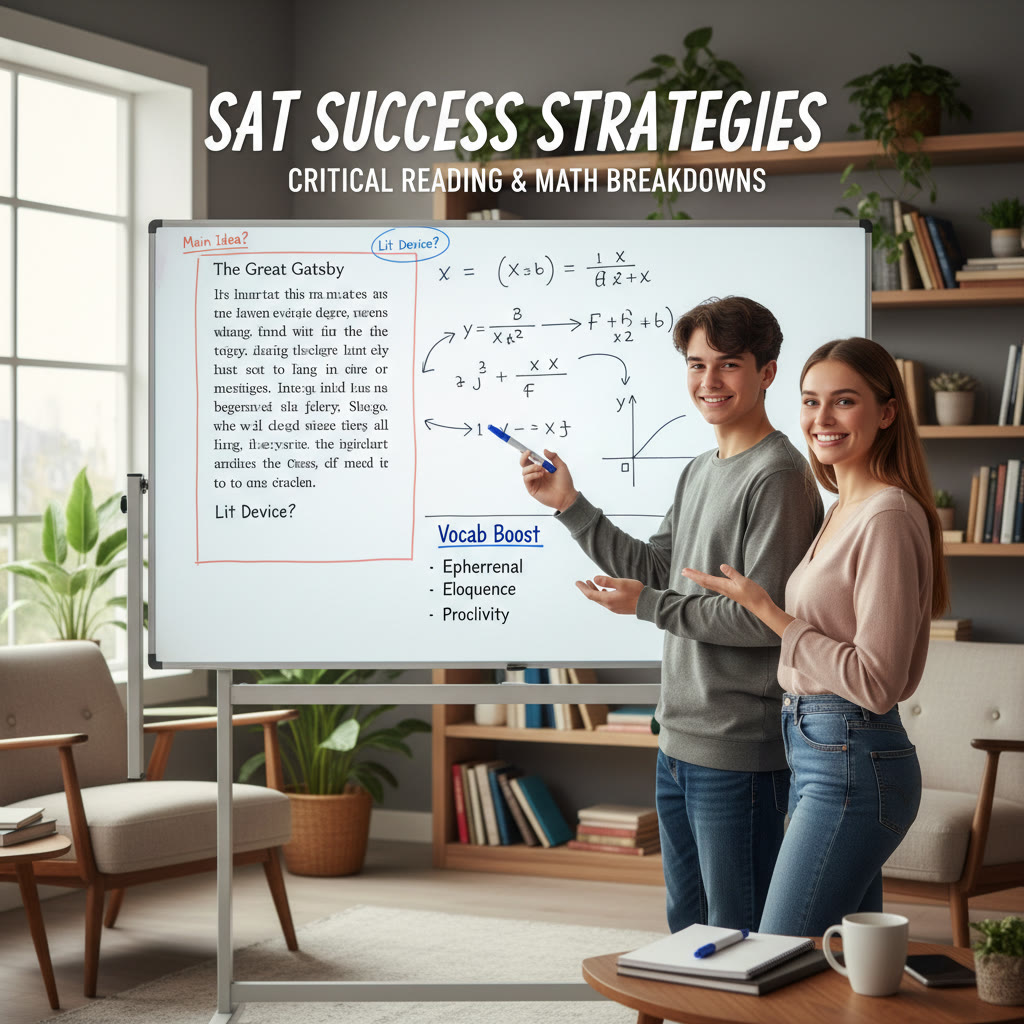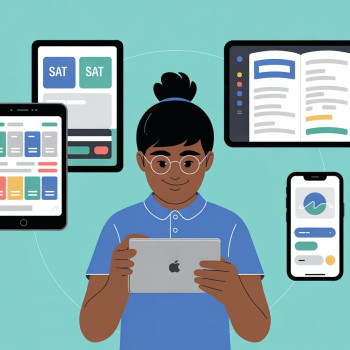The quiet power of untimed practice
When most students think about SAT prep they picture stopwatches, full-length timed sections, and frantic pacing strategies. That urgency has a purpose: the SAT is a timed exam and pacing matters. But there’s another, quieter phase of preparation that often gets overlooked — untimed practice. Think of it as the long, slow simmer that builds flavor. Before you race, you need to learn to run efficiently. Untimed practice is where understanding, technique, and confidence are born.

Why untimed practice is not just “slow practice”
Untimed practice does not mean lazy or indulgent studying. It is a focused, deliberate approach where accuracy, strategy formation, and conceptual clarity take precedence over speed. In this phase you can pause, annotate, compare approaches, and ask the important question: why did I miss that?
There are three fundamental gains from untimed practice:
- Deep comprehension: Problems are analyzed fully. You learn the structure of reading passages, the grammar rules behind Editing questions, and the algebraic reasoning that hides under a deceptively simple equation.
- Strategy development: You draft and refine approaches — how to annotate a passage, how to translate word problems to equations, how to eliminate answer choices logically.
- Confidence building: Mistakes become teachers, not time penalties. With the pressure off, students are more willing to experiment and learn.
Real-world comparison: Learning to cook
Imagine learning to cook a new recipe. Your first try is likely slow: measuring carefully, reading instructions twice, and checking the oven temperature. After several untimed sessions you internalize techniques — chopping methods, heat management, flavor balance — and you can then cook the same dish in half the time without losing quality. The SAT is similar: untimed practice teaches techniques, which you then execute under time pressure.
How untimed practice improves each SAT section
Let’s walk through the main sections of the SAT and see how untimed practice contributes to real gains.
Evidence-Based Reading
Reading comprehension is as much about process as it is about reading speed. In untimed practice you can:
- Annotate passages thoroughly (main idea, author tone, structure, transitions).
- Map question stems to specific lines instead of guessing from memory.
- Practice summarizing paragraphs in one sentence — a skill that speeds up accurate answer selection later.
When you later time yourself, these annotations act as a scaffold. You’ll locate evidence faster and avoid common traps like overreliance on vague memory or panicked elimination.
Writing and Language
Grammar rules and rhetoric choices are durable skills. In untimed practice:
- Work through grammar problems by writing out the sentence structure and substituting parts to test agreement and parallelism.
- Practice rewriting sentences for clarity and concision without the immediate pressure of time.
- Compare multiple correct-sounding edits to see which one preserves meaning and improves style.
These habits reduce second-guessing and speed decision-making in timed situations because you’ve already internalized the reasoning behind each rule.
Math
Math benefits hugely from untimed problem solving. Instead of rushing to guess a formula, untimed practice allows:
- Careful translation of real-world scenarios into mathematical expressions.
- Testing multiple solution paths (algebraic, graphical, logic-based) and selecting the most efficient.
- Building familiarity with commonly used manipulations and shortcuts, so they become mental habits.
As your toolbox expands, timed performance improves because you spend less time deciding which path to take and more time executing it.
How to structure untimed practice: a practical plan
Untimed practice is most effective when it is deliberate and organized. Below is a suggested 8-week untimed-to-timed progression you can adapt to your schedule. This plan assumes you will layer in timed practice later, but the early weeks focus exclusively on untimed work to establish foundations.
| Week | Focus | Untimed Activities | Daily Time |
|---|---|---|---|
| 1 | Diagnostics and baseline | Complete one untimed practice test section per day with thorough review and error tagging | 60-90 minutes |
| 2 | Reading foundations | Annotate passages, practice summarizing, discuss in study journal | 45-75 minutes |
| 3 | Grammar and rhetoric | Work through targeted Writing questions, rewrite sentences, build rule lists | 45-75 minutes |
| 4 | Algebra and problem translation | Solve algebra problems slowly, compare multiple methods, create quick-reference notes | 60-90 minutes |
| 5 | Advanced math concepts | Tackle geometry and advanced algebra untimed, diagram extensively | 60-90 minutes |
| 6 | Integrated practice | Mix sections untimed, refine test strategies and pacing plans | 75-100 minutes |
| 7 | Transition to timed | Start timed mini-sections, compare performance to untimed baseline | 90-120 minutes |
| 8 | Full timed practice | Take timed practice tests with targeted untimed reviews | 3 hours (one full test) plus review |
How to review: quality over quantity
Reviewing after untimed work is where most gains happen. Use an error log and write brief notes:
- What type of mistake was this? (Careless, conceptual, strategy, misread)
- What is the correct reasoning in your own words?
- How will you avoid it in the future? (Annotation habit, formula to memorize, reread technique)
These short reflections turn each error into a durable memory and a concrete action step.
Examples: what untimed practice looks like in action
Here are two short examples to show how untimed practice changes the way students approach problems.
Example 1: Reading passage
Timed approach: Skim the passage, answer questions by scanning, often misreading the author’s tone. The timer forces quick guesses.
Untimed approach: Read the first sentence of each paragraph and write a one-line summary. Circle transitions and note the author’s purpose. For a question about tone you can quote the sentence that supports your answer. After a few untimed sessions this habit becomes second nature — you will later skim with purpose and find answers faster.
Example 2: Math word problem
Timed approach: Convert on the fly, sometimes misidentify variables, and rush through calculations.
Untimed approach: Rewrite the problem in your own words, draw a diagram, define variables explicitly, and test one numeric example to check the model. Untimed practice encourages correct model-building; once models are correct, solving them under time pressure is far quicker.
When to move from untimed to timed practice
Untimed practice should not be endless. The goal is to build a foundation and then apply it under time constraints. Signs you’re ready to introduce timed practice:
- You are consistently accurate on targeted question types.
- Your error log shows fewer conceptual mistakes and more timing-related issues.
- You can explain your solution paths clearly in writing.
Introduce timed practice gradually: start with single sections or mini-timed sets, then progress to full-length timed tests. Use untimed review after each timed attempt to diagnose whether problems are about speed or technique.
Common pitfalls and how untimed practice helps fix them
Here are some recurring problems students face and how untimed practice addresses them.
Pitfall: Skipping the reading
Many students skip close reading to save time, which backfires. Untimed practice trains you to extract the main idea and structure quickly but accurately, reducing the temptation to guess later.
Pitfall: Formula memorization without understanding
Memorizing formulas without context leads to confusion on novel problems. In untimed math practice you learn when to apply formulas and why they work, which increases adaptability when questions deviate from standard forms.
Pitfall: Panic-induced careless errors
Panic makes you misread signs, drop negatives, or choose answer choices that ‘feel right.’ Untimed practice builds the calm habit of checking your work and reading carefully — habits that persist even under timed stress.
How to combine untimed practice with personalized support
Untimed practice is powerful on its own, but pairing it with thoughtful coaching accelerates growth. A tutor can help by:
- Identifying the root cause of recurring errors.
- Modeling how to break down questions during untimed sessions.
- Designing a tailored progression from untimed to timed practice.
For students who want a guided path, Sparkl’s personalized tutoring can be a natural fit. Tutors offer 1-on-1 guidance, create tailored study plans that emphasize untimed skill-building early on, and provide expert feedback on written explanations. When combined with AI-driven insights that highlight patterns in performance, that guidance helps students choose the most effective next steps.
Measuring progress: meaningful metrics beyond score
Untimed practice invites different measures of progress than timed practice. Instead of looking only at score improvements, measure:
- Reduction in conceptual errors per section.
- Time to locate evidence or set up a math equation.
- Number of questions you can explain step-by-step in your own words.
These metrics often predict future score gains because they track durable learning, not momentary speed.
Putting it all together: a study session blueprint
Here is a practical untimed study session you can follow. It emphasizes deliberate practice and reflection.
- Warm-up (10 minutes): Light review of notes or formulas to activate memory.
- Focused untimed block (30-50 minutes): Work through 5-10 challenging problems or one full passage with deep annotation.
- Reflective review (20 minutes): Complete an error log entry for each mistake and write a one-sentence action plan.
- Application task (15 minutes): Re-solve a similar problem or write a 2-3 sentence summary of a passage from memory.
- Optional consult (15-30 minutes): Discuss confusing items with a tutor or peer; if working with Sparkl’s personalized tutoring, use this time to get targeted feedback and adjust your tailored study plan.
Common questions students ask
Won’t untimed practice waste time I could spend on timed tests?
Not if it’s deliberate. Untimed practice early in your prep creates a scaffold for speed. It reduces the number of weaknesses you’ll have to fix under timed conditions, which ultimately saves time and leads to better, more reliable scores.
How much untimed practice is enough?
There is no one-size-fits-all answer. For many students, 4–8 weeks of focused untimed work early in a multi-month plan is ideal. Others may use untimed practice intermittently to master specific weak areas. The key is to transition to timed practice once your accuracy and conceptual understanding reaches a plateau.
Can tutoring speed up the untimed phase?
Yes. A tutor accelerates the feedback loop. With targeted explanation and modeling, you internalize correct approaches faster. If you’re working with a program like Sparkl’s personalized tutoring, the combination of 1-on-1 guidance, tailored study plans, expert tutors, and AI-driven insights helps prioritize the highest-impact untimed work.
Final thoughts: untimed practice as an investment
Untimed practice is an investment in your exam skills. It’s the slow but reliable process that turns flukes into fundamentals. When you treat early prep as a time to learn rather than a time to race, you give yourself the gift of clarity: the ability to recognize structure, to reason accurately, and to stay calm under pressure.
As you move from untimed mastery to timed application, you’ll notice something important — speed becomes a byproduct of skill, not the other way around. That shift is what turns a good test-taker into a confident one. And if you want extra support along the way, thoughtful personalized tutoring that emphasizes these stages — with clear feedback, tailored plans, and data-driven insights — can make that progression smoother and faster.

Keep a curious mindset, celebrate small improvements, and let untimed practice do the heavy lifting. When exam day arrives, your calm competence will show — not because you raced the whole way, but because you built a foundation that carries you through.
Action checklist
- Start with an untimed diagnostic to identify foundational gaps.
- Build a weekly schedule that prioritizes untimed skill work early on.
- Keep an error log and write one action step per mistake.
- Introduce timed practice gradually once conceptual errors decline.
- Consider personalized tutoring for targeted feedback and tailored plans.
Good luck, and remember: mastering the SAT is less about sprinting and more about building a pace you can sustain with clarity and confidence. Untimed practice helps you build that pace — deliberately, thoughtfully, and effectively.


















No Comments
Leave a comment Cancel